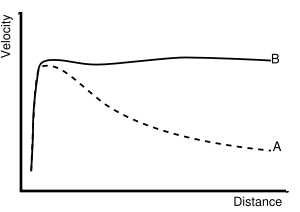 A work for SFMOMA?Standing on Earth and looking out into space, it’s easy to assume that you have it figured out. There are stars, gases, metals-- all 'normal matter' that we can see, made up of electrons and protons. From this vantage point, there is no reason to believe that there is anything else out there. At least this is what astronomers used to believe.
A work for SFMOMA?Standing on Earth and looking out into space, it’s easy to assume that you have it figured out. There are stars, gases, metals-- all 'normal matter' that we can see, made up of electrons and protons. From this vantage point, there is no reason to believe that there is anything else out there. At least this is what astronomers used to believe.
Let's begin by reviewing the hierarchy of objects that are found in the universe. On the small end are solar systems, with a series of planets orbiting around a central star. Galaxies like the Milky Way define the second level. At the highest level are galaxy clusters which are a collection of thousands of galaxies much like a galaxy is made up of billions of stars.
Stepping back to 1933, an astronomer from the California Institute of Technology named Fritz Zwicki was observing the motion of galaxies in the Coma Cluster. Coma is one of our nearest neighbor galaxy clusters, being only 100 million light years away and containing more than 1,000 galaxies. Zwicki observed that the galaxies in the Coma Cluster were moving much faster than predicted. When counting up all the light from the galaxies, he saw that there is not nearly enough mass to create the gravitational attraction responsible for the speed of these galaxies. To account for the missing mass, he postulated the idea of dark matter, which would be invisible to us here on Earth. Invisible matter??? He was ridiculed for his ideas that defied common sense.
Not much else was said about this invisible matter until the 1970's when Vera Rubin, an astronomer from the Carnegie Institution of Washington, started to observe the rotation of nearby galaxies (see figure below*). Much like Zwicki and the Coma Cluster, she saw that the mass from all of the stars did not account for nearly the gravity required to describe the speed at which the galaxies were spinning. To account for the missing matter, she again invoked the dark matter scenario, and again, no one believed her.
Fortunately, technology has finally caught up to the intuition of Rubin and Zwicki. Astronomers now routinely see indirect evidence of this invisible matter at work. It is now generally accepted that dark matter exists, and actually dominates the composition of galaxies. We now believe the universe to be only 4 percent normal matter and 22 percent dark matter.

